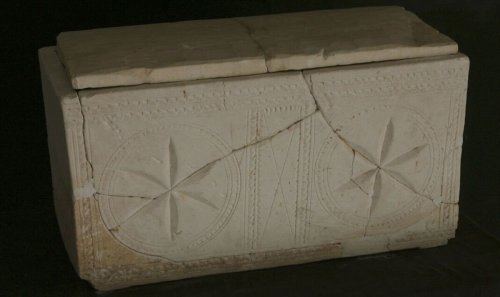


A bone box with the inscription "James, son of Joseph, brother of Jesus" was recently put on display in Atlanta, Georgia. The box is believed to have once held the remains of James the Just, brother of Jesus, making it the oldest physical evidence of Jesus. Despite some controversy and accusations of forgery, the box has been declared authentic by experts.
The James Ossuary: An Ancient Artifact Linked to Jesus
In October 2022, the Israel Antiquities Authority (IAA) put on display in Atlanta, Georgia, a bone box, or ossuary, with an inscription that reads "James, son of Joseph, brother of Jesus." This discovery has generated widespread interest and speculation, as it is believed to be the oldest physical evidence of Jesus himself.
Background
Ossuaries were commonly used by Jewish families in the first century CE to store the bones of their deceased loved ones after the flesh had decomposed. The bones would be placed in a box and then interred in a tomb.
The inscription on the James Ossuary is significant because it provides a direct link to Jesus. The name "James" was common in the first century, but the combination of "James, son of Joseph, brother of Jesus" is extremely rare. This combination of names is only found in the New Testament, where Jesus' brother James is described as one of his disciples.
Controversy and Authenticity
The James Ossuary has not been without controversy. Some scholars have questioned its authenticity, arguing that the inscription could have been added later. However, the IAA has declared the box to be authentic after conducting extensive tests on the inscription and the box itself.
Top 5 FAQs and Answers
The James Ossuary does not provide definitive proof of Jesus' existence, but it does offer strong historical evidence that supports the New Testament accounts.
James the Just was the brother of Jesus and a leader of the early Christian community in Jerusalem. He is described in the New Testament as a pious and respected man.
The James Ossuary was purchased by an American collector in 2002. He donated it to the Israel Antiquities Authority in 2003, where it was stored until its recent public display in Atlanta.
The James Ossuary provides a glimpse into the lives and beliefs of Jesus' family. It also supports the historical accuracy of the New Testament accounts of the early Christian community.
The James Ossuary will continue to be studied by scholars and exhibited to the public. It is anticipated that it will provide valuable insights into the history of Christianity and the life of Jesus.

In a recent family vlog, Indian celebrity couple Shoaib Ibrahim and Dipika Kakar shared their "natural" hair care routine for their son, using a homemade mask made with rice flour, flax seeds, and coconut oil. However, experts warn that what works for adults may not be suitable for babies, whose sensitive skin and scalp could react to the ingredients. While the ingredients may improve hair texture, they do not necessarily promote hair growth. Instead, a healthy diet and good scalp care are more important in maintaining healthy hair.

A recent consumer study has found multiple brands of soft contact lenses in the U.S. to contain "forever chemicals" that can be harmful to both the body and the environment. The study, conducted by the nonprofit organization Environmental Health Sciences, tested 18 varieties of popular contact lenses and found all of them to contain markers for PFAS. Brands such as Acuvue, Alcon, and CooperVision were among the list of affected products. This news serves as a cautionary lesson on the potential risks of overusing contact lenses.

On the birth anniversary of Dr. APJ Abdul Kalam, the ‘Missile Man’ of India, tributes pour in on social media celebrating his life, vision and impact. A visionary scientist, inspiring leader and true patriot, Dr. Kalam's humility, compassion and constant interaction with students continue to inspire generations. His tireless efforts in defense, science and youth empowerment have strengthened India's path towards self-reliance and his legacy continues to motivate young minds to dream big and work hard for the nation.

Recent studies have found that extreme heat, particularly when combined with high humidity, can have a significant impact on mental health. A study in India showed that when wet bulb temperature exceeded 27°C, the probability of reporting severe depression increased by 0.5%, even when the temperature was slightly lower. This finding is consistent with global reviews that have linked high temperatures to mood disorders, increased hospital admissions for psychiatric conditions, and even elevated suicide risk. The Lancet has also published evidence that rising temperatures worldwide are a growing threat to emotional and cognitive health.

In a meeting with university officials in Udaipur, Rajasthan Governor Hari Bhau Bagde stressed the importance of incorporating India's ancient knowledge traditions into academic research. He highlighted the deep repository of knowledge in India since ancient times and urged scholars and scientists to draw upon this tradition in their work. Bagde also suggested making ancient texts available in university libraries for study and research purposes, in order to shape the intellectual abilities and love for the nation among the younger generation.

John Clarke, Michel H. Devoret, and John M. Martinis have been awarded the 2025 Nobel Prize in Physics for their pioneering research into quantum mechanical tunnelling. Their discovery has opened new possibilities for quantum technologies, and will be formally presented on December 10, the anniversary of Alfred Nobel's death. This announcement follows the tradition of recognizing transformative contributions to science, and the award carries a prestigious prize of 11 million Swedish kronor.

The US-Japanese trio of Mary E Brunkow, Fred Ramsdell, and Shimon Sakaguchi have won the 2025 Nobel Prize in physiology or medicine “for their discoveries concerning peripheral immune tolerance". Through their research, they have shown how the immune system is kept in check and why serious autoimmune diseases do not affect everyone. Sakaguchi found a new class of T cells, while Brunkow and Ramsdell discovered the explanation behind a specific mouse strain's vulnerability to autoimmune diseases. Together, they have significantly advanced our understanding of immunology and autoimmune diseases.

Indian astronaut Shubhanshu Shukla, who recently completed a 20-day space mission, shared his insights and experiences at the convocation ceremony of Dr. APJ Abdul Kalam Technical University. He highlighted the importance of patience, focus, and the inevitability of change in achieving success, and urged the graduating class to actively contribute to shaping a fearless and ambitious India.

The Regional Meteorological Centre (RMC) in Chennai has issued a weather alert for parts of Tamil Nadu, with thunderstorms and light to moderate rainfall expected on Saturday. The alert was issued due to the strengthening of a cyclonic circulation in the Bay of Bengal, which is likely to intensify and form a low-pressure area. The system is expected to affect Tamil Nadu, Puducherry, and Karaikal, with some areas experiencing heavy rainfall and gusty winds. The public is advised to stay updated and take precautions, especially in hilly and western districts.

As a step towards advancing India's deep-sea research capabilities, the Union Science Minister announced a landmark contract with the International Seabed Authority to conduct mineral exploration in the Indian Ocean for the next 15 years. This move will not only help India in expanding its scientific knowledge about the deep sea but also has the potential to strengthen its position as a leading player in the international seabed mining industry.